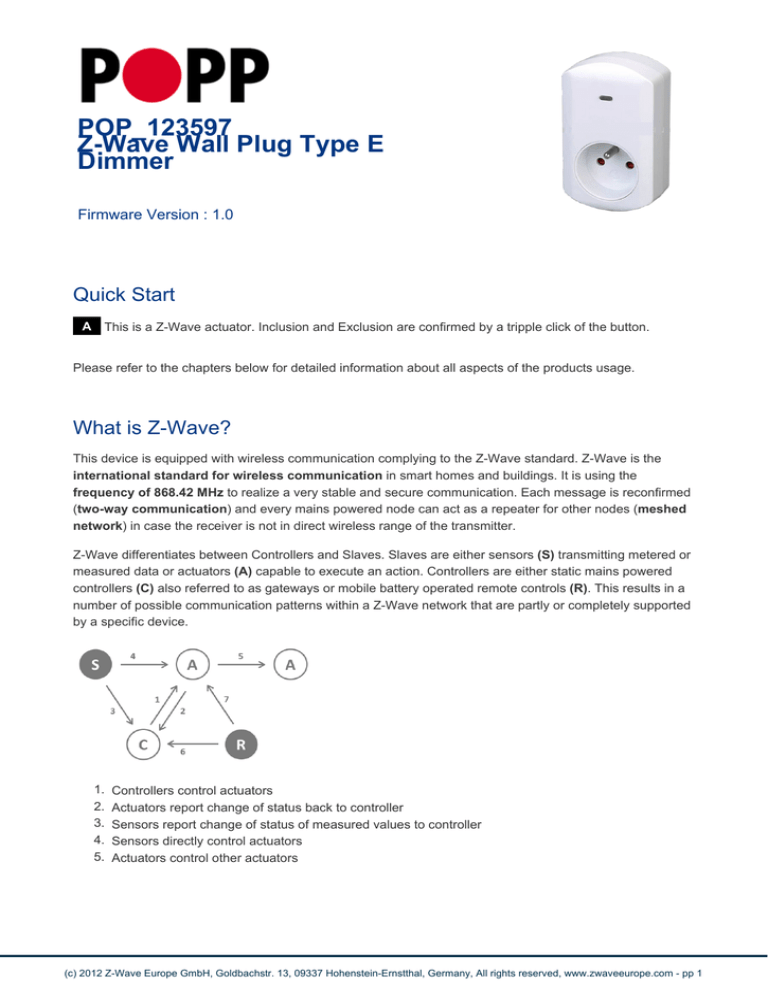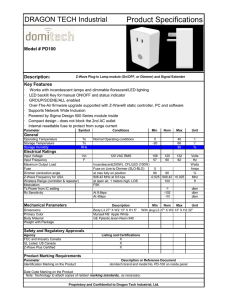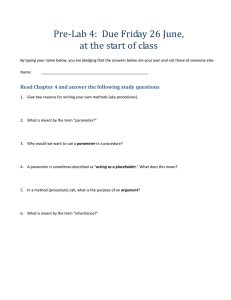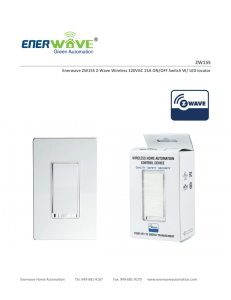
POP_123597
Z-Wave Wall Plug Type E
Dimmer
Firmware Version : 1.0
Quick Start
A This is a Z-Wave actuator. Inclusion and Exclusion are confirmed by a tripple click of the button.
Please refer to the chapters below for detailed information about all aspects of the products usage.
What is Z-Wave?
This device is equipped with wireless communication complying to the Z-Wave standard. Z-Wave is the
international standard for wireless communication in smart homes and buildings. It is using the
frequency of 868.42 MHz to realize a very stable and secure communication. Each message is reconfirmed
(two-way communication) and every mains powered node can act as a repeater for other nodes (meshed
network) in case the receiver is not in direct wireless range of the transmitter.
Z-Wave differentiates between Controllers and Slaves. Slaves are either sensors (S) transmitting metered or
measured data or actuators (A) capable to execute an action. Controllers are either static mains powered
controllers (C) also referred to as gateways or mobile battery operated remote controls (R). This results in a
number of possible communication patterns within a Z-Wave network that are partly or completely supported
by a specific device.
1.
2.
3.
4.
5.
Controllers control actuators
Actuators report change of status back to controller
Sensors report change of status of measured values to controller
Sensors directly control actuators
Actuators control other actuators
(c) 2012 Z-Wave Europe GmbH, Goldbachstr. 13, 09337 Hohenstein-Ernstthal, Germany, All rights reserved, www.zwaveeurope.com - pp 1
6. Remote controls send signals to static controllers to trigger scenes or other actions
7. Remote controls control other actuators.
There are two different role a controller can have. There is always one single primary controller that is managing the
network and including/excluding devices. The controller may have other functions - like control buttons - as well. All other
controllers don't manage the network itself but can control other devices. They are called secondary controllers. The
image also shows that its not possible to operate a sensor just from a remote control. Sensors only communicate with
static controllers.
Product description
This is a wall plug dimmer that can be placed between a wall outlet for Type E and electric devices, plugged
in by cord. It can dim all incandescent lights, high voltage halogen lamps and transformers operated low
voltage lamps without any restriction. Special optimization functions support the dimming of the majority of
dimmable LED lights and Compact Fluorescent Lights (CFLs). The device is IP20 rated and can therefore
only be used in dry environments. The device offers a Baby-Dim Function which dims down a lamp from a
defined level into another defined level in a longer but also definable period (e.g. 20 minutes). An automatic
Light-Off function and programmable dimming and switching behavior makes the device a very flexible tool
for inhouse lighting.
Before Device is installed
Please read carefully the enclosed user manual before installation of the radio-actuator, in order to ensure
an error-free functioning.
ATTENTION: only authorized technicians under consideration of the country-specific installation
guidelines/norms may do works with 230?Volt mains power. Prior to the assembly of the product, the
voltage network has to be switched off and ensured against re-switching.
The product is permitted only for proper use as specified in the user manual. Any kind of guarantee claim
has to be forfeited if changes, modifications or painting are undertaken. The product must be checked for
damages immediately after unpacking. In the case of damages, the product must not be operated in any
case. If a danger-free operation of the equipment cannot be assured, the voltage supply has to be
interrupted immediately and the equipment has to be protected from unintended operation.
Installation Guidelines
The plug can be plugged into every wall outlet for Plug-Type E. It is IP20 rated and can therefore only be
used in dry environments. Do not locate the device facing direct sunlight, humid or dusty place. The suitable
ambient temperature for the device is 0°C ~ 40°C. Plugs must not be stacked and operated.
Behavior within the Z-Wave network
(c) 2012 Z-Wave Europe GmbH, Goldbachstr. 13, 09337 Hohenstein-Ernstthal, Germany, All rights reserved, www.zwaveeurope.com - pp 2
I
On factory default the device does not belong to any Z-Wave network. The device needs to join an
existing wireless network to communicate with the devices of this network. This process is called Inclusion.
Devices can also leave a network. This process is called Exclusion. Both processes are initiated by the
primary controller of the Z-Wave network. This controller will be turned into exclusion respective inclusion
mode. Please refer to your primary controllers manual on how to turn your controller into inclusion or
exclusion mode. Only if the primary controller is in inclusion or exclusion mode, this device can join or leave
the network. Leaving the network - i.e. being excluded - sets the device back to factory default.
If the device already belongs to a network, follow the exclusion process before including it in your network.
Otherwise inclusion of this device will fail. If the controller being included was a primary controller, it has to
be reset first.
Inclusion and Exclusion are confirmed by a tripple click of the button.
Operating the device
The device is able to dim electric loads up to 300 W. The device can be dimmed wirelessly or using the local
button.
Local Operation
The local button has the following functions:
If light is off a short press on the button will turn it either on 100 % or to the last dimming level before turning
off
If light is on - regardless of dimming level - a short press on the button will turn the light off
Keep the button pressed starts to change dimming level slowly. The direction of dimming (up or down)
depends on the direction of the last slow dimming.
The behavior of the button can be configured.
LED Usage
The device has one blue LED used to indicate status information. The behavior of the blue LED can be
configured:
(c) 2012 Z-Wave Europe GmbH, Goldbachstr. 13, 09337 Hohenstein-Ernstthal, Germany, All rights reserved, www.zwaveeurope.com - pp 3
It may show the dimming state. This is the default option.
It may serve as night light. So it's on when the light is off.
It's deactivated.
It can be controlled wirelesly and used as an indicator for other advanced functions.
Automated Dimming Function
If activated the dimmer will turn off automatically after a defined time. This function is particularly useful if the
dimmer is turned on using a motion detector of any other type of sensor. In this case it's possible to further
define the reaction of the dimmer on certain signals sent from a sensor. This allowes a very flexible
application of the dimmer in the house.
Baby Sleeping Function
The device can be used to help babies and little children to find sleep. (It's save to use the device in
childrens rooms or closed to their beds due to the special shutter function that shield the high voltage from
touching). When enabled a double click of the button will turn the light into a definable level and then it will
gradually dim down over time. The time of dimming and the target dimming state - e.g. off - can be
configured as well.
Dimming LEDs and CFLs
LEDs and Compact Flouroscent lights are complicated to dim for two reasons:
There are a so-called reactive load. At the moment of switching on they have virtually not resistance causing
a very high inrush current that may destroy the dimmer device.
The light emission is based on an electronics that may not crease light according to the input power the
dimmer is able to regulate.
There are special LEDs or CFLs that claim to be dimable however almost none of them can be dimmed in
the full range of 0% to 100%. Some will flicker at very low dimming level or sometimes on 100% dimming.
This flickering is not only annoying but also destroys the lighting device. This dimmer allows to set a lower
(configuration parameter 17) and a higher (configuration parameter 18) border for dimming and surpress the
dimming levels that are not supported by the device. On default the dimmer will dim between 0% and 100%.
If you see problems at certain dimming levels, detect the dimming level at your controlling gateway (reading
the dimming value) and change the configuration so that this dimming level will not reached anymore. The
extreme case would be to only support 0% (off) and full diming level (on). This function is supported by all
lights regardless of the technology. In this mode it is recommended to set the fast dimming speed to 0
(Instantly) using configuration parameter no. 5.
(c) 2012 Z-Wave Europe GmbH, Goldbachstr. 13, 09337 Hohenstein-Ernstthal, Germany, All rights reserved, www.zwaveeurope.com - pp 4
Advanced Options for LED and CFL tweakings
The configuration parameters No 51 - 54 allow to configure the dimming behavior on a very technical level.
Do not touch these values unless you know what you do! A dimmer is controlled by the Zero Crossing signal
and the TRIAC Fire pulse. The TRIAC fires every half sine wave max one time. A fire cycles starts with the
Zero Crosssing and then lasts 156 pulse length increments. The value #51 defines the minimum time after
zero crossing because the Triac can fire regardless of the dimming level. Parameter #54 defines whether
the fire pulse has defines length (short) or is extended as long as allowed by the minimum start value in
parameter #54 and the minimum trailing value defines by #53. This value defines the minimum time the
pulse will not be active because of the next zero crossing signal.
Child Protection
The device can be turn into a child protection mode. In this mode all local operation is disabled.
The child protection mode MUST be turned on wirelessly. However in protected by sequence mode it is
possible to unlock the device for local operation with a triple click. The unlock state will last for 5 seconds.
Associations
A
Z-Wave devices control other Z-Wave devices. The relationship between one device controlling
another device is called association. In order to control a different device, the controlling device needs to
maintain a list of devices that will receive controlling commands. These lists are called association groups
and they are always related to certain events (e.g. button pressed, sensor triggers, ...). In case the event
happens all devices stored in the respective association group will receive a common wireless command.
Association Groups:
(c) 2012 Z-Wave Europe GmbH, Goldbachstr. 13, 09337 Hohenstein-Ernstthal, Germany, All rights reserved, www.zwaveeurope.com - pp 5
1 Send Reports on blind state change (max. nodes in group: 5)
Configuration Parameters
Z-Wave products are supposed to work out of the box after inclusion, however certain configuration can
adapt the function better to user needs or unlock further enhanced features.
IMPORTANT: Controllers may only allow to configure signed values. In order to set values in the range 128
… 255 the value sent in the application shall be the desired value minus 256. For example: to set a
parameter to 200? it may be needed to set a value of 200 minus 256 = minus 56. In case of two byte value
the same logic applies: Values greater than 32768 may needed to be given as negative values too.
LED mode (Parameter Number 1, Parameter Size 1) Set LED indication mode
Value
Description
0
Disabled
1
Show switch state
2
Night mode (inverted switch state)
3
Operated by Indicator Command Class (Default)
Automatically switch off after (Parameter Number 2, Parameter Size 2) If not zero, automatically switch off
after a user defined time
Value
0
Description
Disabled (Default)
1 — 65535 sec
What to do on RF off command (Parameter Number 3, Parameter Size 1) Defines how to interpret RF Off
command. Can be used in conjunction with Auto Off function: Ignore - to switch on the light by motion
detectors and switch it off after some amount of time: in case of multiple motion detectors each would try to
switch the light off that would break logics; Switch on - to switch on the light on both On and Off paddle
press on the remote and switch it off after some amount of time. Button off click will still work (if button
operations are not disabled).
(c) 2012 Z-Wave Europe GmbH, Goldbachstr. 13, 09337 Hohenstein-Ernstthal, Germany, All rights reserved, www.zwaveeurope.com - pp 6
Value
Description
0
Switch off (Default)
1
Ignore
2
Switch on
3
Switch on if load is off else switch off
Ignore start level (Parameter Number 4, Parameter Size 1) Defines if the dimmer shall ignore start level in
StartLevelChange command despite it is specified or not
Value
Description
0
No
1
Yes (Default)
Speed for fast dimming (Parameter Number 5, Parameter Size 1) Time to dim on button presses and Set
command (if it has no duration specified). If not 0, dimming will be done smoothly to preserv bulb life.
Value
0
Description
Instantly
1 — 255 in 10ms units (Default 30)
Speed for slow dimming (Parameter Number 6, Parameter Size 1) Time to dim on button holds and
StartLevelChange command (if it has no duration specified).
Value
Description
1 — 255 seconds (Default 3)
Behavior on 'Switch On' (Parameter Number 7, Parameter Size 1) Defines the dim level on command 'ON'.
On default he dimmer restores last dim level. This parameter allows to configure to set maximum level on
second On command (if already On) or to always switch on to maximum level
Value
Description
0
last dim level (Default)
1
maximum dim level when already turned on
2
Always maximum dim level
Baby Dimming time (Parameter Number 8, Parameter Size 1) Time to dim on double click Off button for
Baby-Dim function. This function works only if the load is operated by single press and hold button action. If
enabled, the device will wait for a click timeout to see if the second click would be pressed. This will
introduce a small delay for single click commands
(c) 2012 Z-Wave Europe GmbH, Goldbachstr. 13, 09337 Hohenstein-Ernstthal, Germany, All rights reserved, www.zwaveeurope.com - pp 7
Value
0
Description
Disabled (Default)
1 — 99 in minutes
Target dimming level for Baby Dimming (Parameter Number 9, Parameter Size 1) Target level on which to
stop while executing Baby Dimming. Can be 0 to completely switch off the light.
Value
0 — 255
Description
%
(Default 0)
Typical click timeout (Parameter Number 10, Parameter Size 1) Typical time used to differenciate click, hold,
double and triple clicks
Value
Description
1 — 100 in 10ms units (Default 50)
Limit minimal light level (Parameter Number 17, Parameter Size 1) Minimal level should be greater than
maximal
Value
Description
1 — 95 Level limit (Default 1)
Limit maximal light level (Parameter Number 18, Parameter Size 1) Maximal level should be greater than
minimal
Value
0
Description
Work as switch: use off and maximal level
10 — 99 Level limit (Default 99)
Dim Level on 'Switch On' (Parameter Number 19, Parameter Size 1) defines how the dimmer hall react on a
simple ON Command.
Value
0
Description
Use previous light level (Default)
1 — 99 Define light level in %
Pause before pulse (Parameter Number 51, Parameter Size 1) NB: Do not touch these settings if you are
not sure what they mean! For dimmable LEDs and CFL with bypass use value 1. For other bulbs use default
value.
(c) 2012 Z-Wave Europe GmbH, Goldbachstr. 13, 09337 Hohenstein-Ernstthal, Germany, All rights reserved, www.zwaveeurope.com - pp 8
Value
Description
5 — 60 (Default 28)
Pause after pulse (Parameter Number 52, Parameter Size 1) NB: Do not touch these settings if you are not
sure what they mean! For dimmable LEDs and CFL with bypass use value 40. For other bulbs use default
value.
Value
Description
5 — 60 (Default 28)
Pulse width (Parameter Number 53, Parameter Size 1) NB: Do not touch these settings if you are not sure
what they mean! For dimmable LEDs and CFL with bypass use value 20. For other bulbs use default value.
Value
Description
3 — 20 (Default 10)
Pulse type (Parameter Number 54, Parameter Size 1) NB: Do not touch these settings if you are not sure
what they mean!
Value
Description
0
Long pulse (Default)
1
Short pulse
Command Classes
Supported Command Classes
Basic (version 1)
Multilevel Switch (version 2)
Version (version 1)
Indicator (version 1)
All Switch (version 1)
Configuration (version 1)
Manufacturer Specific (version 1)
Protection (version 1)
Node Naming and Location (version 1)
Association (version 2)
Technical Data
(c) 2012 Z-Wave Europe GmbH, Goldbachstr. 13, 09337 Hohenstein-Ernstthal, Germany, All rights reserved, www.zwaveeurope.com - pp 9
Power Supply
230V ~50-60 Hz
Attachable Loads
resistive and inductive up to 300 W, reactive up to 100 W
Fuse
Type: T 1.25 A H (Load 1.25 Ampere, high shutdown capacity), D: 5 mm,
L: 20 mm
IP Rating
20
Frequency
868.42 MHz (SRD Band)
Wireless Range
up to 100 m outside, on average up to 20 m inside buildings
Explorer Frame Support
Yes
SDK
4.54 pl1
Device Type
Slave with routing capabilities
Generic Device Class
Multilevel Switch
Specific Device Class
Multilevel Power Switch
Routing
Yes
FLiRS
No
Firmware Version
1.0
Explanation of Z-Wave specific terms
Controller — is a Z-Wave device with capabilities to manage the network. Controllers are typically
Gateways, Remote Controls or battery operated wall controllers.
Slave — is a Z-Wave device without capabilities to manage the network. Slaves can be sensors, actuators
and even remote controls.
Primary Controller — is the central organizer of the network. It must be a controller. There can be only one
primary controller in a Z-Wave network.
Inclusion — is the process of bringing new Z-Wave devices into a network.
Exclusion — is the process of removing Z-Wave devices from the network.
Association — is a control relationship between a controlling device and a controlled device.
Wakeup Notification — is a special wireless message issued by a Z-Wave device to annonces that is is
able to communicate.
Node Information Frame — is a special wireless message issued by a Z_Wave device to announce its
capabilities and functions.
Disposal Guidelines
The product does not contain hazardous chemicals.
(c) 2012 Z-Wave Europe GmbH, Goldbachstr. 13, 09337 Hohenstein-Ernstthal, Germany, All rights reserved, www.zwaveeurope.com - pp 10
Do not dispose of electrical appliances as unsorted municipal waste, use separate collection facilities.
Contact your local government for information regarding the collection systems available. If electrical
appliances are disposed of in landfills or dumps, hazardous substances can leak into the groundwater and
get into the food chain, damaging your health and well-being.
(c) 2012 Z-Wave Europe GmbH, Goldbachstr. 13, 09337 Hohenstein-Ernstthal, Germany, All rights reserved, www.zwaveeurope.com - pp 11






